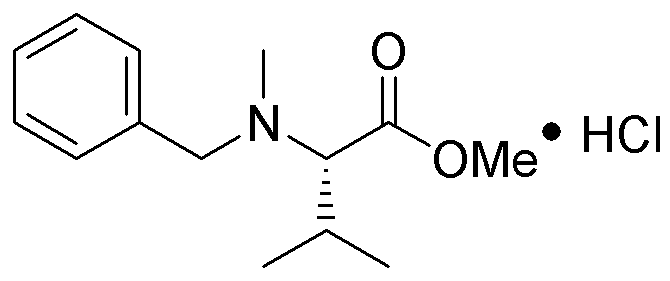Na-Benzyl-Na-methyl-L-valine methyl ester hydrochloride is widely utilized in research focused on:
- Pharmaceutical Development: This compound serves as a key intermediate in synthesizing various pharmaceuticals, particularly in the development of peptide-based drugs.
- Biotechnology: It is used in the production of modified amino acids, which are essential for creating novel proteins and enzymes in biotechnological applications.
- Research in Neuroscience: The compound is studied for its potential effects on neurotransmitter systems, aiding in the understanding of neurological disorders.
- Cosmetic Formulations: It is incorporated into skincare products for its potential benefits in enhancing skin hydration and elasticity.
- Food Industry: The compound can be explored as a flavoring agent or preservative, contributing to the development of innovative food products.
General Information
Properties
Safety and Regulations
Applications
Na-Benzyl-Na-methyl-L-valine methyl ester hydrochloride is widely utilized in research focused on:
- Pharmaceutical Development: This compound serves as a key intermediate in synthesizing various pharmaceuticals, particularly in the development of peptide-based drugs.
- Biotechnology: It is used in the production of modified amino acids, which are essential for creating novel proteins and enzymes in biotechnological applications.
- Research in Neuroscience: The compound is studied for its potential effects on neurotransmitter systems, aiding in the understanding of neurological disorders.
- Cosmetic Formulations: It is incorporated into skincare products for its potential benefits in enhancing skin hydration and elasticity.
- Food Industry: The compound can be explored as a flavoring agent or preservative, contributing to the development of innovative food products.
Documents
Safety Data Sheets (SDS)
The SDS provides comprehensive safety information on handling, storage, and disposal of the product.
Product Specification (PS)
The PS provides a comprehensive breakdown of the product’s properties, including chemical composition, physical state, purity, and storage requirements. It also details acceptable quality ranges and the product's intended applications.
Certificates of Analysis (COA)
Search for Certificates of Analysis (COA) by entering the products Lot Number. Lot and Batch Numbers can be found on a product’s label following the words ‘Lot’ or ‘Batch’.
*Catalog Number
*Lot Number
Certificates Of Origin (COO)
This COO confirms the country where the product was manufactured, and also details the materials and components used in it and whether it is derived from natural, synthetic, or other specific sources. This certificate may be required for customs, trade, and regulatory compliance.
*Catalog Number
*Lot Number
Safety Data Sheets (SDS)
The SDS provides comprehensive safety information on handling, storage, and disposal of the product.
DownloadProduct Specification (PS)
The PS provides a comprehensive breakdown of the product’s properties, including chemical composition, physical state, purity, and storage requirements. It also details acceptable quality ranges and the product's intended applications.
DownloadCertificates of Analysis (COA)
Search for Certificates of Analysis (COA) by entering the products Lot Number. Lot and Batch Numbers can be found on a product’s label following the words ‘Lot’ or ‘Batch’.
*Catalog Number
*Lot Number
Certificates Of Origin (COO)
This COO confirms the country where the product was manufactured, and also details the materials and components used in it and whether it is derived from natural, synthetic, or other specific sources. This certificate may be required for customs, trade, and regulatory compliance.

